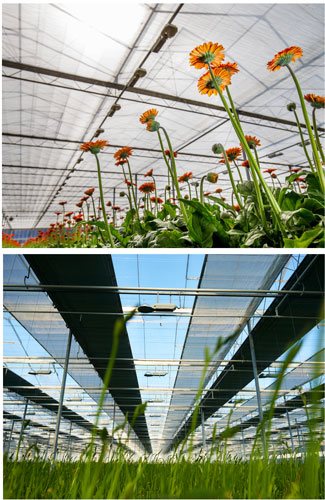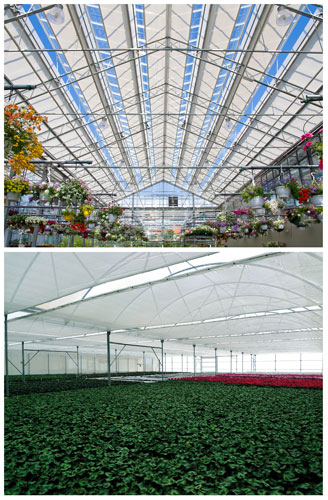4/1/2025
An Update on Upgrades
Dian Smith


As we head into spring and Mother’s Day blinks onto your radar, it’s time to be thinking ahead to that hiatus in the growing year that happens after the spring stock is shipped off to garden centers. It’s at this time that many growers will maintain or upgrade the greenhouse structure and its equipment. It’s hard to do this mid-cycle when there are crops in the way, but by the time mid-May comes around, some research and preparation need to have been done. If not, there can be a stressful rush to source what’s needed.
Pictured: Gerberas grow under a Svensson Harmony screen, known for providing light diffusion through the use of white strips.
• Climate screens help growers manage light, like in this photo where a dual-screen system controls daylength.
“If screens and other important equipment aren’t installed during that period, then start times for key crops can get pushed back,” said Svensson Climate Consultant Paul Arena, who’s based out of Charlotte, North Carolina. “At worst, you can have teams standing around idle when they could be doing vital work. The scheduling for propagating and transplanting later in the spring can be negatively impacted.”
But what are your options when it comes to replacing or upgrading your shade curtains?
“Different greenhouse structures require different kinds of shade options,” said Paul. “Shorter greenhouses heat up much more quickly and would require more shade compared to a taller greenhouse that can control more warmth in the larger volume of greenhouse space.”
Venlo structure greenhouses
Venlo structures are higher than most other greenhouses and can benefit from lower shade levels. Growers who have these kinds of houses tend to be at the high-tech end of the industry.
“For these growers, they’ll be able to maximize the amount of light entering the structure, and then limit radiation using advanced shade screen management and automation,” Paul said.
“Generally, you would install a 40% to 50% shade screen and a blackout screen that would provide light deprivation,” he added. “It depends on your crop, but many perennials demand shorter daylengths. This kind of setup also allows you to prevent flowering, which can be a useful health strategy for the crop because when a crop flowers in the greenhouse the falling petals can promote fungal disease pressure.”
A quality consideration is to make sure that any blackout screen deployed is providing total light restriction. Light is a powerful tool for growers to leverage. Just a percentage point of light can cause a crop to flower.
Another solution commonly seen among North American ornamental growers is Svensson’s dual-screen system, PARperfect. PARperfect combines a blackout screen with a highly-diffusive Harmony screen, allowing growers to adjust shading levels from 20% to 100%, similar to a light dimmer. This approach gives growers greater control over light levels in their greenhouse, allowing them to adjust their daily light integral (DLI) to accommodate different crop types. The Plant Company in Stuarts Draft, Virginia, has adopted this system in its potted plant greenhouse, leading to more balanced light distribution and shade level control.
Open MX roofs
An MX-style greenhouse allows both sides of the peak to fully open, allowing the roof to be completely open to the outside air (and forming an “M” shape when closed and an “X” shape when open).
“Oftentimes, you’ll want shade screens that are more durable and will be able to withstand outdoor conditions,” said Paul. “You would want an exterior-grade screen employed in those situations. The exterior-rated screens are generally open-structure and are designed for airflow through the screen, as well as shade. They are ideal for shading the crop and promoting airflow.”
Alternatively, there are closed-structure screens. These are for keeping the warmth in and will preserve a homogeneous climate in the greenhouse, avoiding cold shock in the canopy in the event that cold air pours in.
The closed-structure screens can preserve the indoor environment when the humidity strategy calls for the windows to be opened. It adds a little important flexibility.
A good Svensson screen for this kind of operation would be the Harmony 5120 O E. That will maximize the cooling capacity of the greenhouse.
“If a grower wants a closed-structure screen, the Harmony 4945 would be a good choice. Growers can also use that screen in the wintertime as an energy screen,” explained Paul.

Gutter connect (with or without ridge vents)
These are again lower structures. They don’t have the space to divert a warm layer of air away from the canopy like the taller Venlo structures. Smaller spaces just warm up faster under the sun—think of a car with closed windows, compared to a large veranda of a family house on the same warm day.
“We’ll be looking for shade in the 50% to 60% shade range,” said Paul. “What’s important is the airflow because there may be no roof vents.”
Pictured: MX-style greenhouse growers can choose between an exterior screen for airflow or a closed-structure screen for energy savings.
• Gutter-connected growers rely on closed-structure shade curtains for full solar protection and to block superheated attic air from reaching crops.
Gutter connect growers will look for a closed-structure shade curtain. It provides a fully protective shade layer against solar radiation, but also a near-to-hermetic seal, which prevents the superheated attic space air from entering the growing compartment below.
Below those closed-structures screens, there will be active ventilation or an air exchange system blowing the hot air that’s accumulating in the greenhouse. In Svensson’s range, the Harmony 5747 FR is ideal for these conditions because it reflects more radiation than it absorbs and it has a closed-structure.
Planning ahead
Planning for a turnaround in the spring isn’t only a matter of pulling together the growing team; it pays to bring in finance and get them planning, too.
State and regional programs, generally structured through utility providers, allow for generous rebates to growers who can show that a new shade curtain investment will increase energy efficiency. Applying is a process many growers know well, though it can be a burden to get updated on current rebate levels, criteria and deadlines. For this reason, Svensson gathers data on regional rebate opportunities in a series of guides, along with the screen options that are eligible for funding.
“It’s second nature for my colleagues at Svensson to be familiar with the rebate programs, but the guides are a good first step,” said Paul. “Sometimes it’s just good to know there isn’t a new program you’re missing out on—and sometimes there is!” GT
Dian Smith is General Manager of Ludvig Svensson.